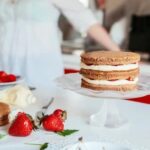Are you ready to learn how to decorate a cake like a professional? Whether you’re an amateur baker looking to up your cake decorating game or someone who simply wants to impress their friends and family with beautifully decorated cakes, mastering the art of cake decoration is a valuable skill. Achieving professional-looking results can seem daunting, but with the right tools, techniques, and guidance, it’s definitely attainable.
Cake decoration goes beyond just making a cake look pretty – it’s about adding that extra special touch to celebrate life’s moments. From birthdays and weddings to graduations and anniversaries, a beautifully decorated cake can instantly elevate any occasion.
The desire to create impressive designs often leads us to admire the work of professional bakers and wonder how they achieve such stunning results. Fortunately, with the right knowledge and practice, you too can create show-stopping cakes that rival those made by professionals.
In this article, we’ll guide you through the essential tools and ingredients for cake decorating, give detailed steps on preparing the perfect cake for decorating, provide tips and techniques for working with buttercream and fondant, explain various piping techniques, offer advice on adding intricate details and finishing touches, all aimed at helping you achieve professional-looking results in your cake decoration endeavors.
So let’s roll up our sleeves (and fondant) and get ready to turn those ordinary cakes into extraordinary works of edible art.
Essential Tools and Ingredients
Decorating a cake like a professional requires not only skill and creativity but also the right tools and ingredients. Essential tools for cake decorating include piping bags, different tips, offset spatula, fondant, and edible decorations. Piping bags come in various sizes and materials, such as disposable plastic or reusable cloth.
Different tips allow for a range of designs, from intricate details to smooth borders. An offset spatula is essential for spreading frosting and achieving a smooth finish on the cake. Fondant is another key ingredient for creating sleek and polished designs on cakes, while edible decorations such as sprinkles, pearls, and edible flowers add the finishing touches.
In addition to the tools mentioned above, other essential items for cake decoration include a turntable for easy maneuvering while frosting the cake, a bench scraper for smoothing out surfaces, and a pastry brush for applying syrups or glazes. These tools help to ensure precision and professional-looking results when decorating a cake. When it comes to ingredients, high-quality butter, sugar, flour, eggs, and flavorings are crucial for baking a delicious base for decorating.
Aspiring bakers should invest in these essential tools and ingredients to achieve professional-looking results in cake decoration. While it can be tempting to cut corners with makeshift tools or lower-quality ingredients, having the right equipment and materials can make all the difference in creating beautifully decorated cakes that rival those made by professionals.
Preparing the Cake
When it comes to cake decorating, the foundation of a beautifully decorated cake starts with a perfectly baked and prepared cake. Whether you are making a classic vanilla cake, a rich chocolate cake, or a flavorful red velvet cake, the key to achieving professional-level decoration lies in the preparation of the base. Here are some detailed steps on how to bake a perfect cake for decorating, including leveling and crumb coating.
Choosing the Right Recipe
The first step in preparing a cake for decoration is choosing the right recipe. Depending on your flavor preferences and the type of decoration you have in mind, select a tried and tested recipe that yields a moist and flavorful cake. It’s important to follow the recipe accurately and measure all ingredients carefully to ensure consistent results every time.
Baking and Cooling
Once you have prepared your batter, carefully pour it into prepared cake pans and bake according to the recipe’s instructions. Be sure not to overbake your cakes, as this can result in dryness and difficulty when it comes time to decorate. After baking, allow the cakes to cool completely in their pans on wire racks before removing them.
Leveling and Crumb Coating
Before you can begin decorating your cake, it’s essential to level each layer to ensure an even surface for decorating. A simple tool such as a long serrated knife or a dedicated cake leveler can be used for this purpose. Once leveled, apply a thin layer of frosting or buttercream around the entire cake to create what is known as a crumb coat.
This helps seal in any loose crumbs from the leveled surface before applying the final layer of frosting. With these steps completed, your cakes will be ready for further decoration techniques.
Mastering Buttercream
Buttercream is a versatile and delicious frosting that is commonly used for cake decoration. To achieve professional-looking results, it is essential to master the art of working with buttercream. Here are some tips and techniques to help you create smooth and flawless cake decorations using buttercream:
1. Choosing the Right Consistency: One of the most important aspects of working with buttercream is achieving the right consistency. Whether you’re using Swiss meringue, Italian meringue, or American buttercream, the frosting should be smooth, creamy, and easy to spread. Adjusting the consistency by adding more powdered sugar for a stiffer frosting or a small amount of milk for a softer texture can make all the difference in achieving a flawless finish.
2. Crumb Coating: Before applying the final layer of buttercream, it’s essential to do a crumb coat. This thin layer of frosting seals in any loose crumbs on the cake, preventing them from appearing in the final decoration. Spread a thin layer of buttercream over the cake, then refrigerate it until firm before applying the final coat.
3. Smooth Application: When applying buttercream to your cake, use an offset spatula to spread it evenly across the surface. Start by adding a generous amount to the top of the cake and work your way down the sides. For a flawlessly smooth finish, consider investing in a bench scraper or icing smoother tool to achieve professional results.
By mastering these tips and techniques for working with buttercream, you’ll be well on your way to creating beautifully decorated cakes that look as though they were made by a professional pastry chef. So grab your piping bags and offset spatula and start practicing – soon enough, you’ll be decorating cakes like a pro.
Working With Fondant
Fondant is a popular choice for cake decoration due to its smooth finish and versatility. Working with fondant can seem intimidating at first, but with the right techniques and practice, anyone can achieve professional-looking results. The first step in working with fondant is to ensure that the cake has been properly leveled and crumb coated with a layer of buttercream. This provides a smooth base for applying the fondant.
Once the cake is ready, it’s important to knead the fondant until it becomes pliable and smooth. Dusting your work surface with powdered sugar or cornstarch prevents sticking as you roll out the fondant to the desired thickness. Carefully lift the rolled fondant using a rolling pin and drape it over the cake, gently smoothing it down the sides to avoid air bubbles or wrinkles.
After covering the cake with fondant, it’s time to get creative with decorations. Fondant can be shaped and molded into intricate details such as flowers, bows, or figurines. Using food coloring gels, different shades can be achieved to add depth and dimension to these decorations. With patience and attention to detail, working with fondant offers endless opportunities for unique and personalized cake designs.
| Key Points | Details |
|---|---|
| Kneading Fondant | Ensure that fondant is kneaded until pliable and smooth before rolling. |
| Rolling Out Fondant | Dust work surface with powdered sugar or cornstarch to prevent sticking while rolling out fondant. |
| Decorating with Fondnat | Fondant can be shaped into intricate details such as flowers, bows, or figurines for personalized cake designs. |
Piping Techniques
Piping techniques are essential skills that can take your cake decorating to the next level. There are various piping tips and designs that you can use to create beautiful and intricate patterns on your cakes. One of the most popular techniques is creating rosettes, which are delicate swirls of frosting that add a touch of elegance to any cake.
Shells are another classic design that adds texture and dimension to the cake’s surface, while borders help frame the edges and give a polished look. Writing with frosting can be a unique way to personalize cakes for special occasions such as birthdays, weddings, or anniversaries.
To master piping techniques, it’s important to have the right tools, including piping bags and a variety of tips in different shapes and sizes. Practice is also crucial in achieving precision and consistency in your designs. With patience and dedication, you can enhance your cake designs with beautiful piped details.
In addition to traditional piping techniques, modern trends in cake decoration include using flowers, leaves, and other intricate designs made from buttercream or royal icing. These delicate decorations require a steady hand and attention to detail but can create stunning visual effects on cakes. Experimenting with different piping techniques will allow you to develop your own style and create unique and professional-looking cakes for any occasion.
| Piping Technique | Description |
|---|---|
| Rosettes | Delicate swirls of frosting for an elegant touch. |
| Shells | Adds texture and dimension to the cake’s surface. |
| Borders | Frames the edges and gives a polished look. |
| Writing | Personalizes cakes for any special occasion. |
Adding Details
When it comes to decorating a cake like a professional, adding intricate details and edible decorations can truly elevate the overall look of the cake. Here are some tips and techniques to help you achieve that professional touch:
- Use edible flowers or fresh fruit: Adding real flowers or fresh fruit as decoration not only adds a pop of color to the cake but also brings a natural and organic aesthetic to the design.
- Utilize edible paints or food coloring: Whether you’re painting delicate designs directly onto the cake or using food coloring to create vibrant patterns, incorporating these artistic elements can make your cake look like a work of art.
- Employ piping for intricate designs: Piping intricate lace patterns, delicate filigree, or even tiny floral accents can bring a level of sophistication and elegance to your cake decoration.
It’s important to remember that less is often more when it comes to adding details and edible decorations. Overcrowding the cake with too many elements can make it look cluttered and unprofessional. Instead, focus on a few key details that will enhance the overall design without overwhelming it.
Additionally, consider using contrasting textures and colors when adding details to your cake. For example, if your cake features smooth fondant, consider adding crunchy elements like edible pearls or gold leaf for visual interest. By strategically incorporating different textures and colors, you can create a visually stunning and professional-looking decorated cake.
Finishing Touches
When it comes to cake decoration, the finishing touches are what truly set a professional-looking cake apart from the rest. After putting in the time and effort to prepare the cake, master buttercream and fondant techniques, and add intricate details, it’s essential to focus on the final steps to ensure a polished and professional finish. This section will provide tips and techniques for smoothing buttercream, cleaning up edges, and presenting the final product.
Smoothing Buttercream
One of the key components of achieving a professional-looking cake is having smooth and flawless buttercream. To achieve this, start by using an offset spatula to apply a generous amount of buttercream onto the top of the cake.
Then, use the spatula to gently spread and smooth the buttercream across the top and sides of the cake. For an even smoother finish, consider using a bench scraper or a cake smoother to gently go over the surface of the cake, removing any excess buttercream and creating a sleek finish.
Cleaning Up Edges
After smoothing out the buttercream, it’s important to clean up any excess frosting along the edges of the cake. Use a small offset spatula or a clean paper towel to carefully remove any smudges or imperfections on the sides of the cake. Taking this extra step will give your cake clean edges and a professional look.
Presenting the Final Product
Once your cake is decorated and finished, presentation is key in showcasing your hard work. Consider placing your finished cake on a decorative cake stand or board that complements its design. You can also add some final touches such as fresh flowers, edible glitter, or dragees for an added wow factor. In addition, take photos of your masterpiece from various angles to capture all its intricate details before serving or delivering it.
By focusing on these final steps – smoothing buttercream, cleaning up edges, and presenting your final product – you can elevate your decorated cakes to look like they were professionally made in no time.
Conclusion
In conclusion, decorating a cake like a professional requires the right tools, ingredients, and techniques. By mastering buttercream and fondant, practicing piping techniques, adding intricate details, and finishing touches, anyone can achieve professional-looking results in cake decoration. The key is to practice and experiment with different methods to find what works best for individual preferences and styles.
It’s important to remember that achieving professional-looking cake decoration takes time and patience. As with any skill, practice makes perfect. Don’t be discouraged if the first few attempts don’t turn out as expected – learning from mistakes is all part of the process. Experimenting with various techniques and being open to trying new ideas can lead to finding a unique style that sets any cake decorator apart.
In the end, the most important thing about cake decorating is having fun and being creative. Whether it’s for a special occasion or just for personal enjoyment, putting effort into creating a beautifully decorated cake can truly elevate any celebration. So, don’t be afraid to get creative, try new things, and most importantly – enjoy the journey of mastering the art of cake decoration.
Frequently Asked Questions
How Do I Make My Cake Look Professional?
Making a cake look professional involves paying attention to details such as smooth and even frosting, straight layers, and clean edges. Using techniques like crumb coating, smoothing the icing with a bench scraper, and using a turntable can help achieve a polished, professional look.
What Do Professionals Use to Decorate Cakes?
Professionals use various tools to decorate cakes, including piping bags and tips for creating intricate designs with frosting, fondant for covering cakes and creating decorations, edible paints and dusts for adding color and detail, as well as tools for shaping and molding fondant or gum paste.
What Are the 7 Different Cake Decorating Techniques?
The seven different cake decorating techniques include piping, which involves using different tips to create designs with frosting; fondant work involving rolling out fondant to cover cakes or create decorations; gum paste flowers which require molding realistic-looking flowers from gum paste; buttercream painting where edible colors are used to paint directly on buttercream frosting; stenciling for creating intricate patterns on cakes; icing combing for textured buttercream finishes; and airbrushing for adding color gradients or effects to cakes.
Each technique requires practice and precision to master.

Welcome to my blog about home and family. This blog is a place where I will share my thoughts, ideas, and experiences related to these important topics. I am a stay-at-home mom with two young children. I hope you enjoy reading it! and may find some helpful tips and ideas that will make your home and family life even better!





